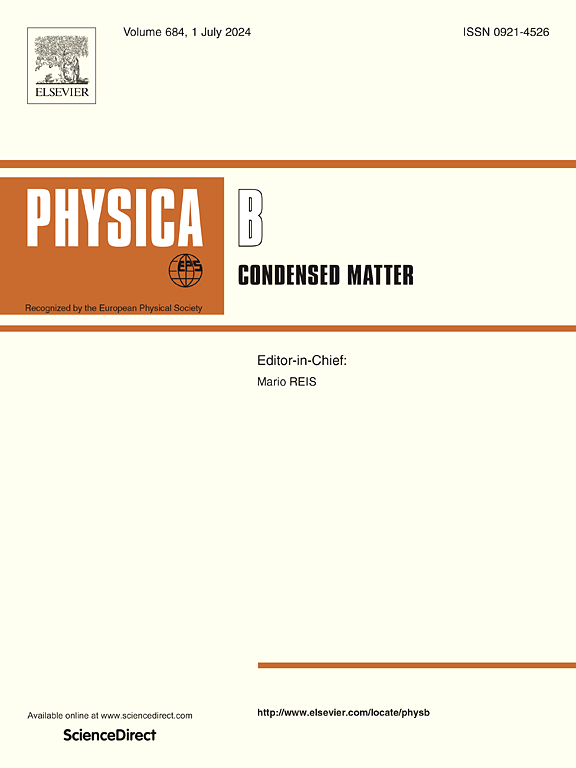Molecular dynamics simulation of the tensile properties of polycrystalline α-Fe: Effects of hydrogen concentration, temperature, and grain size
IF 2.8
3区 物理与天体物理
Q2 PHYSICS, CONDENSED MATTER
引用次数: 0
Abstract
Hydrogen embrittlement (HE) significantly degrades the mechanical properties of steel materials. Under varying hydrogen concentrations and temperatures, the HE behavior of materials with smaller grain sizes and a higher proportion of grain boundaries (GB) differs markedly from that of polycrystalline materials with larger grain sizes. Molecular dynamics simulations were employed to study the uniaxial tensile behavior and deformation mechanisms of polycrystalline α-Fe models under different hydrogen concentrations, temperatures, and grain sizes. The results show that as the hydrogen concentration increases from 0 % to 1 %, the ultimate tensile strength (UTS) and fracture strain (εf) of the steel decrease significantly. Beyond 1 % hydrogen concentration, the UTS of models with smaller grain sizes continues to decrease. The saturation hydrogen concentration for models with grain sizes of 2.84 and 2.5 nm is 1 %, while for the 2.14 nm grain size model, the hydrogen concentration does not reach saturation. As the grain size decreases, the proportion of grain boundaries increases, leading to a higher corresponding saturation hydrogen concentration. The peak stress of each model decreases with increasing temperature. The hydrogen diffusion coefficient decreases with decreasing grain size and also decreases with lower temperatures. Models with smaller grain sizes can weaken the suppression of local energy release by hydrogen atoms, thereby reducing their promoting effect on crack initiation and propagation. Therefore, the smaller the grain size, the better the material's resistance to HE. This study elucidates the rules of hydrogen-grain size-temperature interactions on mechanical properties on an atomic scale, providing a theoretical basis for understanding hydrogen embrittlement behavior in steel.
α-Fe多晶拉伸性能的分子动力学模拟:氢浓度、温度和晶粒尺寸的影响
氢脆(HE)会显著降低钢材料的力学性能。在不同的氢浓度和温度下,小晶粒尺寸和高晶界(GB)比例的材料的HE行为与大晶粒尺寸的多晶材料的HE行为明显不同。采用分子动力学模拟方法研究了不同氢浓度、温度和晶粒尺寸下多晶α-Fe模型的单轴拉伸行为和变形机理。结果表明:当氢浓度从0%增加到1%时,钢的极限抗拉强度(UTS)和断裂应变(εf)显著降低;当氢浓度超过1%时,晶粒尺寸较小的模型的UTS继续降低。对于2.84和2.5 nm的模型,氢的饱和浓度为1%,而对于2.14 nm的模型,氢的饱和浓度未达到饱和。随着晶粒尺寸的减小,晶界所占比例增大,相应的饱和氢浓度也相应增大。各模型的峰值应力随温度的升高而减小。氢扩散系数随晶粒尺寸的减小而减小,随温度的降低而减小。较小晶粒尺寸的模型可以减弱氢原子对局部能量释放的抑制,从而降低其对裂纹萌生和扩展的促进作用。因此,晶粒尺寸越小,材料的抗HE性能越好。本研究在原子尺度上阐明了氢-晶粒尺寸-温度相互作用对力学性能的影响规律,为理解钢中的氢脆行为提供了理论基础。
本文章由计算机程序翻译,如有差异,请以英文原文为准。
求助全文
约1分钟内获得全文
求助全文
来源期刊

Physica B-condensed Matter
物理-物理:凝聚态物理
CiteScore
4.90
自引率
7.10%
发文量
703
审稿时长
44 days
期刊介绍:
Physica B: Condensed Matter comprises all condensed matter and material physics that involve theoretical, computational and experimental work.
Papers should contain further developments and a proper discussion on the physics of experimental or theoretical results in one of the following areas:
-Magnetism
-Materials physics
-Nanostructures and nanomaterials
-Optics and optical materials
-Quantum materials
-Semiconductors
-Strongly correlated systems
-Superconductivity
-Surfaces and interfaces
 求助内容:
求助内容: 应助结果提醒方式:
应助结果提醒方式:


